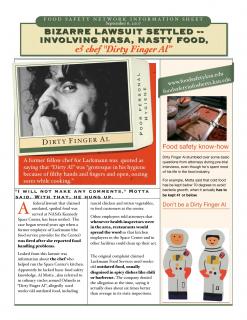Seven years ago, after a couple of post-pick-up hockey discussions about placing food safety information on bulletin boards above urinals, food safety infosheets were born. The idea was to take stories pulled for FSNet (now bites.ksu.edu) and give them to food handlers because hey, who doesn’t like a good story. Targeted at the food service industry, food safety infosheets were intended to provide compelling food safety risk-reduction information and generate behavior change.
After churning infosheets out semi-weekly for a year, those who were receiving them provided anecdotes suggesting that they had become useful passive, postable communication tools.
Great. But we needed to actually measure that the infosheets worked. Too often fantastic communication ideas are implemented with no evaluation conducted (or severely limited evaluation) to confirm whether the tools actually do anything. Surveys, focus groups and other methodologies focusing on behavior change have a place in food safety research, but alone, tell us more about what individuals think than how they act. In a 2003 review of consumer food safety studies (Journal of Food Protection 66:130-161) , Liz Redmond and Chris Griffiths wrote:
The direct observation of human and animal behavior is believed by social scientists to be superior to other methods of data collection. This belief stems from the assumption that data gathered through the direct observation of actions reflect those behaviors directly rather than through intermediary means such as a questionnaire.
Observation is awesome because practices aren’t viewed through a filter. Video observation is more awesome because individual actions can be stopped, rewound, slowed down and viewed by multiple people from multiple angles. Using video observation to evaluate any behavior change that the infosheets might create became the focus of a three-year project that was published yesterday.
After striking up a relationship with a major international foodservice company around the use of infosheets,, their extremely open and progressive food safety dude allowed our team into their kitchens with our macbooks and webcams, let us to ask their employees for permission to record them working, and we were off. In a true demonstration of a good food safety culture, the company wanted to know how well their training programs and other tools (like the infosheets) might be working. No one expressed concern over what we might see – they wanted to know where they should concentrate resources.
We recorded 47 employees at 8 different sites making meals and snacks for a couple of days. Infosheets were posted weekly for seven weeks (including this one, Zappa picking his nose, exactly as shown; aptly known as the “Dirty Finger Al” infosheet) and then we went back with our voyeur tools and recorded again. We generated 348 hours of observation data (and about a year of video analysis).
The infosheets worked. After being exposed to the weekly postings, cross-contamination events went down (20%) and handwashing attempts went up (7%). There were some other gems that we were able to glean from the data including charting risky events by hour of the day and getting a better handle on the prevalence of cross-contamination.
Since September 2006 over 150 food safety infosheets have been produced and are available for download at no cost at www.foodsafetyinfosheets.com. The website has had a recent redesign, adding a search function, automatic email alerts and RSS feeds. The new database is also sortable by pathogen, location and risk factor.
Assessment of Food Safety Practices of Food Service Food Handlers: Testing a Communication Intervention
Chapman, Benjamin; Eversley, Tiffany; Filion, Katie; MacLaurin, Tanya; Powell, Douglas
Journal of Food Protection, Volume 73, Number 6, June 2010 , pp. 1101-1107
Globally, foodborne illness affects an estimated 30% of individuals annually. Meals prepared outside of the home are a risk factor for acquiring foodborne illness and have been implicated in up to 70% of traced outbreaks. The Centers for Disease Control and Prevention has called on food safety communicators to design new methods and messages aimed at increasing food safety risk-reduction practices from farm to fork. Food safety infosheets, a novel communication tool designed to appeal to food handlers and compel behavior change, were evaluated. Food safety infosheets were provided weekly to food handlers in working food service operations for 7 weeks. It was hypothesized that through the posting of food safety infosheets in highly visible locations, such as kitchen work areas and hand washing stations, that safe food handling behaviors of food service staff could be positively influenced. Using video observation, food handlers (n = 47) in eight food service operations were observed for a total of 348 h (pre- and postintervention combined). After the food safety infosheets were introduced, food handlers demonstrated a significant increase (6.7%, P < 0.05, 95% confidence interval) in mean hand washing attempts, and a significant reduction in indirect cross-contamination events (19.6%, P < 0.05, 95% confidence interval). Results of the research demonstrate that posting food safety infosheets is an effective intervention tool that positively influences the food safety behaviors of food handlers.
